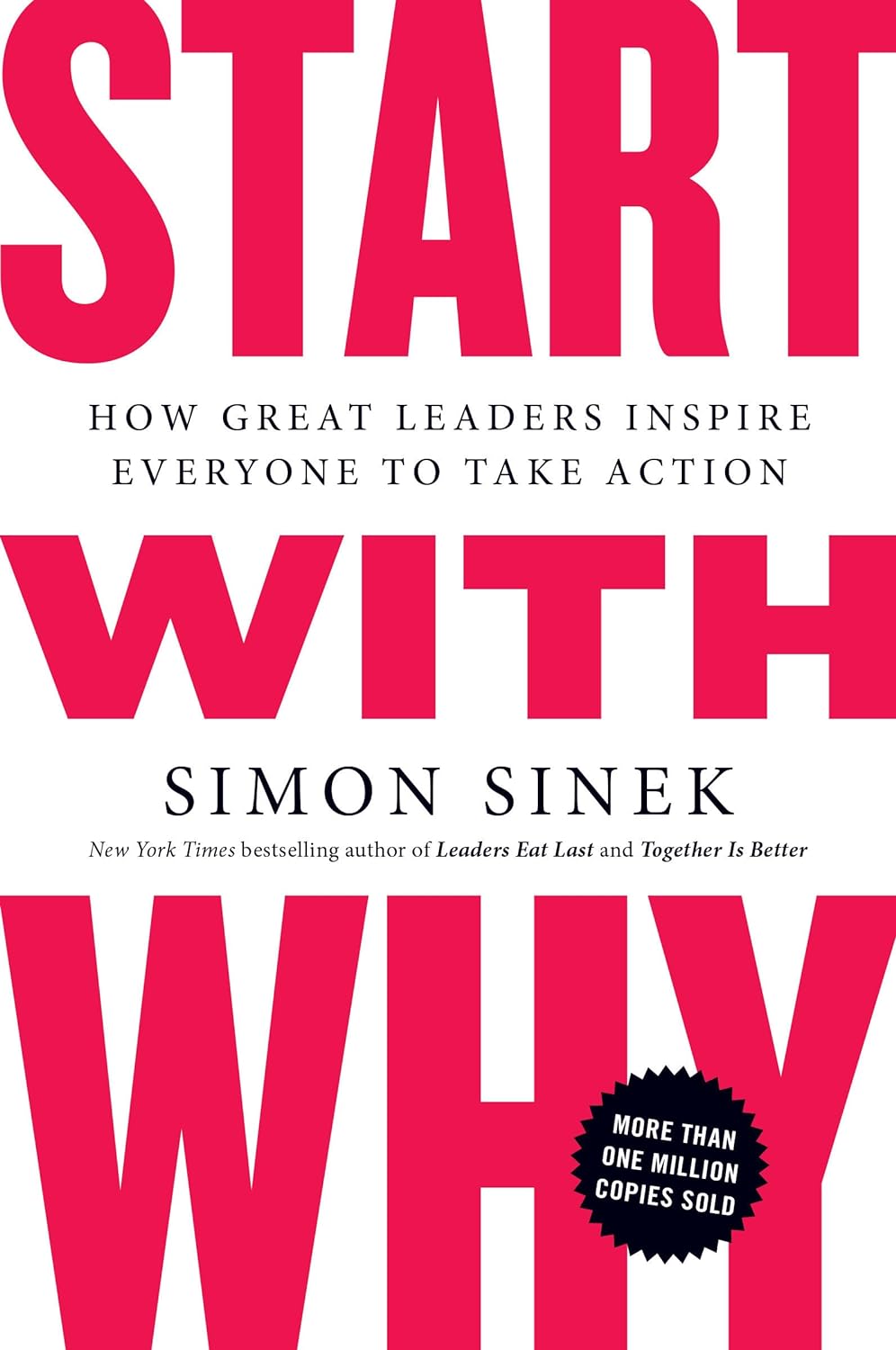
Simon Sinek’s Start with Why: How Great Leaders Inspire Everyone to Take Action is a powerful exploration of leadership, motivation, and the underlying principles that drive the most successful individuals and organizations. First published in 2009, the book has become a foundational text for leaders and entrepreneurs seeking to inspire action and cultivate a sense of purpose in their teams. Sinek’s central premise revolves around the idea that leaders who start with “why” – a deep sense of purpose and mission – are more effective at inspiring others and achieving long-term success than those who focus solely on “what” they do or “how” they do it.
Start with Why is divided into multiple sections that systematically build Sinek’s argument, starting with an introduction to the “Golden Circle” concept, which is the framework used throughout the text. The “Golden Circle” consists of three concentric circles: “Why” at the center, followed by “How,” and “What” on the outermost layer. “Why” represents the purpose or cause that drives an organization or individual; “How” involves the process or values that bring the “Why” to life, and “What” refers to the products or services an organization offers. According to Sinek, most companies and leaders operate from the outside in, starting with “What” and working towards “Why,” but the truly inspiring ones work from the inside out – they start with “Why.”
The Importance of “Why”
Sinek argues that “Why” is the most crucial component of the Golden Circle because it addresses the core question of purpose: Why do we do what we do? He believes that having a clear sense of purpose gives organizations and individuals a reason to exist that goes beyond making money or achieving short-term goals. When leaders start with “Why,” they tap into a powerful emotional connection that resonates with both employees and customers, fostering loyalty and trust.
For instance, Sinek discusses how companies like Apple succeed not just because they make great products (the “What”) or have efficient manufacturing processes (the “How”), but because they operate with a clear sense of “Why.” Apple’s “Why” is to challenge the status quo and empower individuals to think differently. This fundamental belief is infused in everything Apple does, which in turn attracts customers who share the same values. By focusing on why they do what they do, Apple builds a deeper connection with its customers, who feel like they are part of a movement rather than just buying a product.
The concept of starting with “Why” extends beyond business and can be applied to all forms of leadership. Sinek references figures like Martin Luther King Jr. and the Wright brothers, who were able to inspire others and create movements because they operated with a clear and compelling “Why.” For King, the goal was not simply to end segregation but to create a society where all people are treated equally. Similarly, the Wright brothers were driven not just by the desire to build a flying machine but by the belief that they could change the world by making flight possible for mankind. In both cases, the “Why” was the foundation that motivated others to join the cause and take action.
The Role of “How” and “What”
While “Why” forms the core of Sinek’s framework, the book does not diminish the importance of “How” and “What.” Rather, it emphasizes that “How” and “What” should derive from “Why.” The “How” refers to the specific actions and values that a leader or organization employs to bring the “Why” to life. This could involve corporate culture, operational strategies, or leadership styles. When the “How” is aligned with the “Why,” it reinforces the organization’s purpose and helps create consistency in behavior and decision-making.
The “What” – the products or services offered – becomes more meaningful when it is a direct expression of the “Why.” Companies that start with “What” tend to prioritize features, benefits, and price points without necessarily connecting to a deeper purpose. As a result, they may struggle to differentiate themselves in a competitive marketplace. On the other hand, companies that start with “Why” can create products and services that are perceived as authentic and aligned with their purpose, thus attracting a more loyal customer base.
Biological Basis for Starting with “Why”
An interesting aspect of Start with Why is Sinek’s attempt to link the Golden Circle to human biology. He argues that the brain is divided into three main components that correspond to the layers of the Golden Circle: the neocortex, which handles rational and analytical thought and corresponds to the “What,” and the limbic brain, which governs feelings, behaviors, and decision-making, aligning with the “Why.” By understanding this biological basis, Sinek contends that leaders can better grasp why starting with “Why” resonates so powerfully with people. The “Why” appeals directly to the limbic brain, which is responsible for emotional responses and gut feelings, leading to a deeper connection with followers.
Real-World Applications and Case Studies
Sinek uses a range of real-world examples to illustrate how starting with “Why” works in practice. One of the most compelling case studies in the book is that of Southwest Airlines. Southwest operates with a clear “Why” – to democratize the skies and make air travel accessible to everyone. This purpose has guided their business decisions, from offering low fares to adopting a no-frills service model. The company’s focus on “Why” has not only differentiated it from other airlines but has also created a strong culture among its employees, who are motivated by the belief that they are part of a larger mission.
Another example is Harley-Davidson, a company that has cultivated a passionate community of riders who share the belief that Harley-Davidson is more than just a motorcycle brand; it’s a symbol of freedom and rebellion. By starting with “Why,” Harley-Davidson has built a loyal customer base that identifies with the brand’s values and is willing to pay a premium for its products.
Critiques and Limitations
While Start with Why: How Great Leaders Inspire Everyone to Take Action offers an inspiring and thought-provoking perspective on leadership, there are some critiques and limitations to consider. One critique is that Sinek’s approach may oversimplify the complexities of business success. The idea that starting with “Why” alone can lead to long-term achievement might not fully account for other critical factors like market dynamics, competition, and economic conditions. Furthermore, some readers might find that the book overemphasizes anecdotal evidence and lacks robust empirical support for its claims. While the case studies are compelling, they don’t always establish a causal relationship between starting with “Why” and sustained success.
Additionally, while the book stresses the importance of finding one’s “Why,” it does not provide a detailed framework for discovering or articulating it. The process of identifying a genuine and motivating purpose can be challenging, especially for established organizations with ingrained cultures and practices. Readers might need to seek additional resources or workshops to effectively implement the “Why” approach.
The Relevance of “Start with Why” in Today’s World
Despite some limitations, Start with Why remains highly relevant, especially in today’s world where purpose-driven businesses are gaining traction. Consumers are increasingly seeking brands that stand for something beyond profit, and employees are looking for meaningful work where they can make a difference. Sinek’s message resonates in a time when corporate social responsibility and sustainability are not just buzzwords but essential components of an organization’s strategy.
In the modern landscape, where technology is rapidly changing and competition is fierce, the “Why” can serve as a stabilizing force. Companies that operate with a clear purpose are better equipped to navigate uncertainty because they have a guiding principle that informs decision-making and keeps them focused on their long-term vision. This is particularly evident in the rise of companies like Tesla, whose “Why” is to accelerate the world’s transition to sustainable energy. Tesla’s purpose drives its innovation and has cultivated a dedicated following that believes in the company’s mission.
.

.
Conclusion
Simon Sinek’s Start with Why: How Great Leaders Inspire Everyone to Take Action presents a compelling argument that starting with “Why” is the foundation for effective leadership and lasting success. Through the Golden Circle framework, the book offers a fresh perspective on how organizations can inspire loyalty and motivate employees and customers by connecting to a deeper sense of purpose. While the book may not offer a comprehensive solution for all aspects of leadership, its emphasis on the importance of “Why” is a powerful reminder that purpose-driven leadership is essential for inspiring action and fostering long-term growth.
Sinek’s insights challenge conventional thinking about leadership and provide valuable lessons for anyone seeking to make a meaningful impact, whether in business, politics, or everyday life. In a world where many companies and individuals prioritize short-term gains and “What” they offer, Start with Why stands as a call to refocus on the reasons behind our actions, urging leaders to ask not just what they do or how they do it, but most importantly, why they do it.
Check out Start with Why: How Great Leaders Inspire Everyone to Take Action on Amazon.
If you found this interesting please share it with friends and family, and why not check out some of our other book reviews.
.
